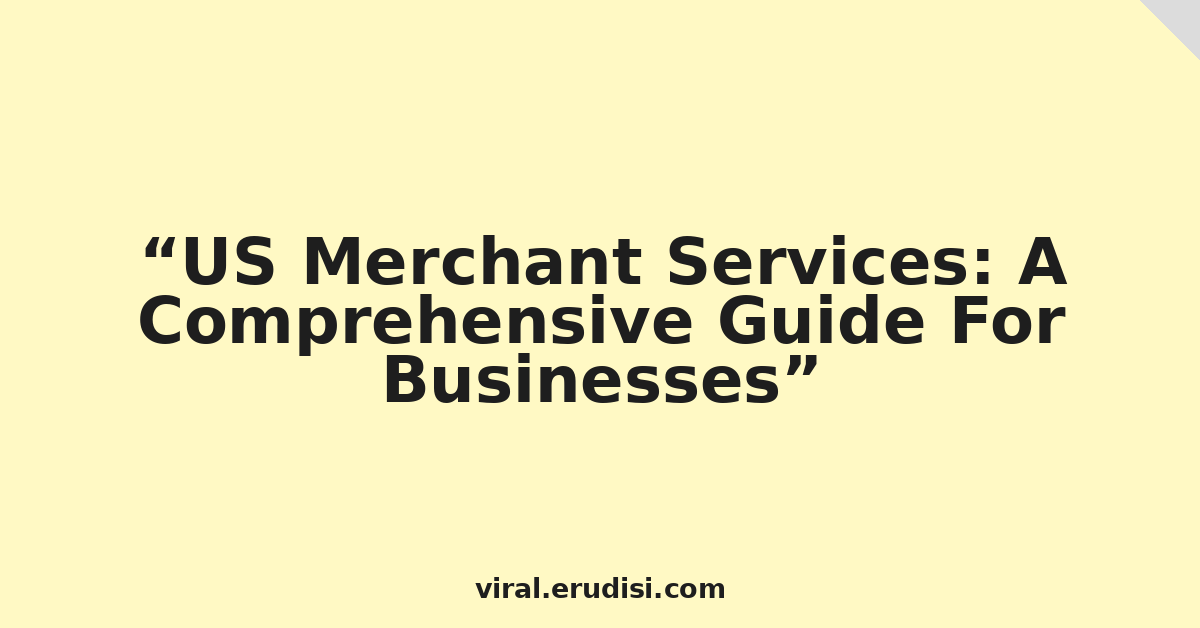In today’s fast-paced digital economy, accepting payments is no longer an option for businesses, it’s a necessity. Whether you’re a small brick-and-mortar store, an e-commerce giant, or a mobile service provider, the ability to process payments efficiently, securely, and affordably is critical to your success. This is where US Merchant Services come into play. They provide the infrastructure and tools that enable businesses to accept various forms of payment, manage transactions, and ultimately, grow their revenue.
Hallo Reader viral.erudisi.com! Welcome to an in-depth exploration of US Merchant Services. We’ll delve into what they are, how they work, the different types available, the factors to consider when choosing a provider, and the benefits they offer. This guide is designed to equip you with the knowledge you need to make informed decisions about your payment processing needs, whether you’re just starting your business journey or looking to optimize your existing payment setup.
What are US Merchant Services?
US Merchant Services encompass a range of financial services that facilitate the acceptance of payments by businesses. These services typically include:
- Payment Processing: This is the core function, involving the authorization, capture, and settlement of payment transactions. It involves securely transmitting payment information between the merchant, the customer’s bank (issuing bank), and the merchant’s bank (acquiring bank).
- Merchant Accounts: These are bank accounts that allow businesses to receive and hold funds from customer payments. They act as a crucial intermediary in the payment process, ensuring that funds are properly routed and managed.
- Payment Gateways: These are software applications that securely transmit payment information from a customer to the payment processor. They act as a bridge between your website or point-of-sale (POS) system and the payment processor.
- Point-of-Sale (POS) Systems: These are hardware and software solutions that enable businesses to process payments in person. They often include features such as inventory management, sales reporting, and customer relationship management (CRM).
- Credit Card Terminals: These are physical devices that allow businesses to accept credit and debit card payments. They can be countertop terminals, mobile card readers, or integrated into POS systems.
- E-commerce Solutions: These are integrated payment processing solutions specifically designed for online businesses. They typically include shopping cart integration, fraud prevention tools, and recurring billing options.
- Fraud Protection: US Merchant Services often include tools and services designed to protect businesses from fraudulent transactions, such as address verification service (AVS) and card verification value (CVV) checks.
- Reporting and Analytics: Most providers offer reporting tools that allow businesses to track sales, analyze payment trends, and gain insights into their customer behavior.
- Customer Support: Reliable customer support is essential for resolving issues and addressing questions related to payment processing.
How US Merchant Services Work: The Payment Processing Lifecycle
Understanding the payment processing lifecycle is crucial for businesses to appreciate the complexity and security involved in accepting payments. Here’s a simplified overview:
- Customer Initiates Payment: The customer provides their payment information (credit card number, expiration date, CVV, etc.) to the merchant. This can be done online, in person, or over the phone.
- Payment Information is Transmitted: The merchant’s payment gateway or POS system encrypts the payment information and securely transmits it to the payment processor.
- Authorization Request: The payment processor sends an authorization request to the customer’s issuing bank (the bank that issued the credit card). This request confirms that the customer has sufficient funds or credit available.
- Authorization Response: The issuing bank approves or declines the transaction and sends an authorization response back to the payment processor.
- Capture and Settlement: If the transaction is approved, the payment processor captures the funds from the issuing bank and transfers them to the merchant’s merchant account. This process is often referred to as "settlement."
- Funds Availability: The merchant can access the funds in their merchant account, typically after a settlement period (e.g., 1-3 business days).
Types of US Merchant Services
The landscape of US Merchant Services is diverse, catering to the varying needs of businesses. Here are some of the most common types:
- Traditional Merchant Accounts: These are the most common type and are offered by banks and independent sales organizations (ISOs). They typically involve a merchant account, a payment gateway, and a credit card terminal or POS system.
- High-Risk Merchant Accounts: These accounts are designed for businesses that are considered high-risk, such as those in the adult entertainment, online pharmacy, or gambling industries. They often have higher fees and stricter requirements.
- E-commerce Payment Gateways: These are specialized payment processing solutions for online businesses. They integrate with e-commerce platforms and provide secure payment processing capabilities.
- Mobile Payment Processors: These services enable businesses to accept payments on the go using mobile devices, such as smartphones and tablets. They often involve mobile card readers and mobile payment apps.
- Payment Service Providers (PSPs): These are third-party companies that provide payment processing services to businesses. They often offer a simplified setup process and lower fees than traditional merchant accounts. Popular PSPs include PayPal, Stripe, and Square.
- Integrated POS Systems: These are comprehensive POS systems that combine payment processing with other business management tools, such as inventory management, sales reporting, and CRM.
Factors to Consider When Choosing a US Merchant Services Provider
Selecting the right US Merchant Services provider is a critical decision that can significantly impact your business’s profitability and efficiency. Here are some key factors to consider:
- Pricing and Fees: Compare the various pricing models, including transaction fees, monthly fees, setup fees, and any other hidden costs. Ensure that the fees are transparent and competitive.
- Security: Prioritize providers that adhere to industry-standard security protocols, such as PCI DSS compliance. Look for features like encryption, fraud protection, and tokenization.
- Payment Methods Accepted: Ensure that the provider supports the payment methods your customers prefer, such as credit cards, debit cards, mobile wallets (Apple Pay, Google Pay), and ACH transfers.
- Hardware and Software Compatibility: Verify that the provider’s hardware and software are compatible with your existing POS system or e-commerce platform.
- Customer Support: Choose a provider that offers reliable and responsive customer support, including phone, email, and chat options.
- Contract Terms: Carefully review the contract terms, including the length of the contract, cancellation fees, and any early termination penalties.
- Scalability: Consider whether the provider can accommodate your business’s future growth and expansion.
- Reputation and Reviews: Research the provider’s reputation and read reviews from other businesses to assess their reliability and customer satisfaction.
- Fraud Protection Tools: Evaluate the provider’s fraud prevention tools and features, such as AVS, CVV checks, and fraud monitoring.
- Reporting and Analytics: Assess the quality and comprehensiveness of the provider’s reporting and analytics tools.
Benefits of Using US Merchant Services
Implementing US Merchant Services offers numerous benefits for businesses:
- Increased Sales: Accepting a wide range of payment methods makes it easier for customers to make purchases, leading to increased sales and revenue.
- Improved Customer Experience: Providing a seamless and secure payment experience enhances customer satisfaction and builds loyalty.
- Reduced Risk of Fraud: Robust fraud protection tools help minimize the risk of fraudulent transactions and chargebacks.
- Streamlined Operations: Payment processing solutions automate the payment process, saving time and effort.
- Improved Cash Flow: Faster settlement times allow businesses to access funds more quickly.
- Data-Driven Insights: Reporting and analytics tools provide valuable insights into sales trends, customer behavior, and payment patterns.
- Professional Image: Accepting credit and debit cards enhances the professional image of your business.
- Competitive Advantage: Offering convenient payment options can give your business a competitive edge in the marketplace.
- Global Reach: E-commerce payment solutions allow businesses to reach a global customer base.
- Compliance and Security: Providers handle compliance with PCI DSS and other security standards, reducing the burden on businesses.
Conclusion
US Merchant Services are an essential component of modern business operations. By understanding the different types of services available, the payment processing lifecycle, and the factors to consider when choosing a provider, businesses can make informed decisions that optimize their payment processing capabilities, enhance customer experience, and ultimately, drive revenue growth. As technology continues to evolve, the landscape of US Merchant Services will undoubtedly continue to evolve as well. Staying informed about the latest trends and innovations will be crucial for businesses to remain competitive and thrive in the digital economy. Remember to carefully research and compare providers to find the best fit for your specific business needs.

